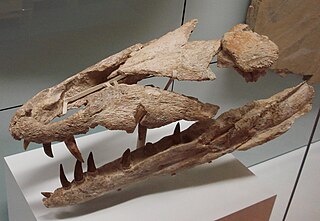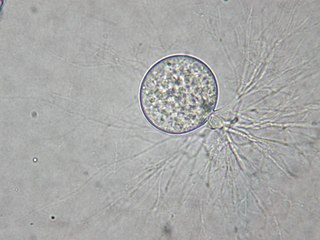
Edmund Georg Hermann Landau was a German mathematician who worked in the fields of number theory and complex analysis.

Dakosaurus is an extinct genus of crocodylomorph within the family Metriorhynchidae that lived during the Late Jurassic and Early Cretaceous. It was large, with teeth that were serrated and compressed lateromedially. The genus was established by Friedrich August von Quenstedt in 1856 for an isolated tooth named Geosaurus maximus by Theodor Plieninger in 1846. Dakosaurus was a carnivore that spent much, if not all, its life out at sea. The extent of its adaptation to a marine lifestyle means that it is most likely that it mated at sea, but since no eggs or nests have been discovered that have been referred to Dakosaurus, whether it gave birth to live young at sea like dolphins and ichthyosaurs or came ashore like turtles is not known yet. The name Dakosaurus means "biter lizard", and is derived from the Greek dakos ("biter") and σαῦρος -sauros ("lizard").

In mathematics, a Schottky group is a special sort of Kleinian group, first studied by Friedrich Schottky.

Carnidae, also known as bird flies or filth flies, is a family of flies (Diptera). There are 6 genera, containing about 93 species worldwide.

Alexander Carl Heinrich Braun was a German botanist from Regensburg, Bavaria. His research centered on the morphology of plants.

Fungi of the order Chytridiales, like other members of its division, may either have a monocentric thallus or a polycentric rhizomycelium. When the ribosomal genes of members classified in this order were first examined using molecular techniques, it was discovered that the order contained some species that were not related. With the culture and characterization of Chytridium olla, the type species of this order, the limits of the Chytridiales were established. The Chytridiales is now monophyletic and species such as Polychytrium aggregatum, Chytriomyces angularis and Cladochytrium replicatum have been transferred to other orders.

The Rosenmund–von Braun synthesis is an organic reaction in which an aryl halide reacts with cuprous cyanide to yield an aryl nitrile.

Carl Braun, sometimes Carl Rudolf Braun alternative spelling: Karl Braun, or Karl von Braun-Fernwald, name after knighthood Carl Ritter von Fernwald Braun was an Austrian obstetrician. He was born 22 March 1822 in Zistersdorf, Austria, son of the medical doctor Carl August Braun.

FriedrichWilhelm Zopf was a well-known German botanist and mycologist. He dedicated to his whole life with fungal biology, particularly in classification of fungi and dye production in fungi and lichens. Besides, his textbook on fungi called “Die pilze in morphologischer, physiologischer, biologischer und systematischer beziehung ” in 1890 was also an outstanding work on the subject for many decades. The unicellular achlorophic microalgae Prototheca zopfii is named after him because of his profound suggestions and contributions to Krüger's pioneering work in Prototheca. Thus, his numerous contributions gave him a special status in mycological history.
Olpidium is a fungal genus in the family Olpidiaceae. Members of Olpidium are zoosporic pathogens of plants, animals, fungi, and oomycetes.
Olpidiaceae is a fungal plant pathogen family of genera that was placed in the order Olpidiales.
The Chytridiaceae are a family of fungi in the order Chytridiales. The family contains 33 genera and 238 species according to a 2008 estimate.
Canteria is a fungal genus in the family Endochytriaceae. A monotypic genus, it contain the single species Canteria apophysata, a parasite of the alga Mougeotia. The genus was circumscribed by John S. Karling in 1971.
Entophlyctis is a genus of fungi currently classified in the family Chytriomycetaceae. The genus, widespread in temperate regions and contains about 20 species.

Chytriomyces is the type genus of fungi in the family Chytriomycetaceae. The genus was described by mycologist John Sidney Karling in 1945. The family, created by Peter Letcher in 2011, contains species with a Group I-type zoospore, distinguishing it from Chytridiaceae members, which have a Group II-type zoospore.

The Chytriomycetaceae are a family of fungi in the order Chytridiales.
Dendrochytridium is a fungal genus in the order Chytridiales. The genus is monotypic, containing the single saprobic species Dendrochytridium crassum, isolated from detritus collected from an Australian tree canopy. Both the genus and species were described as new to science in 2013. Phylogenetically, Dendrochytridium crassum groups together in a clade with other fungi possessing Group II-type zoospores. These fungi, which include representatives from the genera Chytridium, Phlyctochytrium, Chytriomyces, and Polyphlyctis are classified in the family Chytridiaceae.

Rhizoclosmatium is a genus of fungi classified in the family Chytriomycetaceae. It was circumscribed by Danish mycologist Henning Eiler Petersen in 1903. The genus contains four species.

Aeorestes is a subgenus of Lasiurus commonly known as the hoary bats.

Dithrycini is a tribe of tephritid or fruit flies in the family Tephritidae.












